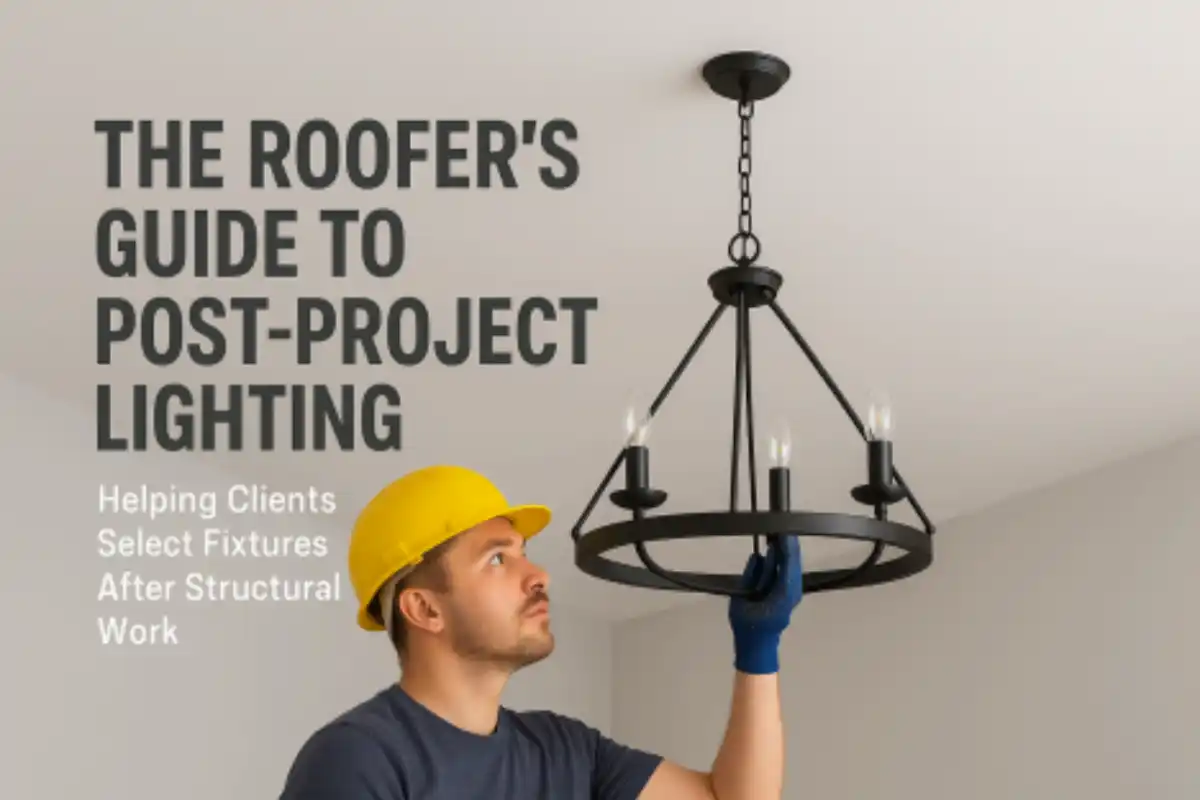Every experienced roofer knows that the conversation doesn’t end when the last shingle is secured. More often than not, clients who’ve just invested in significant roofing work start asking about the next phase: “Now that we’ve opened up the ceiling, what about upgrading our lighting?”
This is where smart roofing professionals can add tremendous value. By guiding clients through their post-project lighting decisions, roofers can create a seamless transition from structural improvements to stunning residential lighting solutions. From recommending inexpensive chandeliers to helping families explore affordable ceiling lights or cheap pendant lights, the guidance you provide ensures both safety and style for your client’s home.
Understanding Structural Impact on Lighting Choices
When you’re working on a roof, you’re essentially reshaping the backbone of a home’s upper structure. Every modification from reinforcing trusses to adding collar ties directly impacts what kind of house light fixtures and interior ceiling lights can be supported safely.
What size chandelier for my dining room? This is one of the most common client questions. Standard ceiling joists typically handle about 10 pounds per square foot, but reinforced trusses from roofing work can often support heavier fixtures, including modern farmhouse lighting or large entryway chandelier ideas.
Documentation is crucial here. Smart roofers photograph and map joist locations, noting which beams received reinforcement during the project. This ensures electricians can later install budget chandelier ideas or even heavy LED chandelier options with confidence. It also answers questions like: “How much weight can a ceiling support?” and “Why do chandeliers need proper support?”
Budget-Smart Lighting Solutions After Major Roofing Investment
After spending thousands on a new roof, most homeowners feel financially stretched. Yet this is often the best time to address lighting because structural access is still easy. Clients want style without overspending, which makes home lighting deals and discount lighting fixtures especially attractive.
Which lights are best for living room updates after roofing? Homeowners can consider indoor house lights like bedroom ceiling lights, kitchen pendant lights, or flush mount ceiling lights that maximize comfort and efficiency. Improved insulation from roofing upgrades also
means homes are better suited for energy-efficient fixtures, preventing overheating and cutting electricity bills.
When to upgrade lighting after renovation? Ideally, within 30–60 days. Acting early means electricians can coordinate with roofing changes, ensuring smoother installation and lower lighting installation costs. This timing also helps clients who ask: “How to save money on light fixtures?” since contractors often bundle services.
Energy efficiency plays a big role, too. Today’s LED chandelier options consume up to 75% less energy, multiplying the savings from a well-insulated roof. For clients exploring residential lighting suppliers or searching for a “chandelier store near me”, recommending energy efficient fixtures is a simple way to add long-term value.
Special Roofing Projects and Their Lighting Opportunities Different roofing projects open doors to unique lighting upgrades.
● Cathedral ceilings: These dramatic spaces beg for bold fixtures. Clients often ask “What lighting works with cathedral ceilings?” In such cases, tiered inexpensive chandeliers or linear chandelier height calculator references help find the right fit. If the ceiling is slanted, roofers can explain, “Can you install chandelier on slanted ceiling?” and recommend adjustable mounts.
● Vaulted spaces: Homeowners wonder, “How to choose chandelier for vaulted ceiling?” Larger, tiered designs or dining room lighting ideas provide proportion and balance. ● Skylight installations: Natural light brings new considerations. Fixtures with dimming
functions balance sunlight and artificial illumination. Pairing skylights with affordable ceiling lights ensures flexibility throughout the day.
● Attic conversions: When turning an attic into a living space, clients often ask “Which lights are best for low ceilings?” Here, flush mount ceiling lights or pendant lights make the room feel more open.
● Flat-to-pitched roof conversions: These often create angled ceilings that work beautifully with track systems or modern farmhouse lighting to highlight architectural details.
Professional Tips and Common Pitfalls
Helping homeowners with lighting decisions means asking the right questions: “What’s your daily lighting routine?” or “Which lights are best for living room vs. kitchen?” These details guide fixture selection, whether for interior ceiling lights or entryway chandelier ideas.
Pitfalls to avoid include:
● Overloading new beams with overly heavy chandeliers.
● Installing fixtures before structural settling is complete (why do chandeliers sag after installation? Often, this is the reason).
● Ignoring moisture ratings in bathrooms near improved ventilation.
Always recommend certified indoor lighting contractors for hardwired jobs. Partnering with a trusted ceiling light installation service or local home lighting showroom not only protects clients but also reinforces your reputation as a full-service advisor.
Conclusion
Roofing professionals who guide clients beyond shingles and gutters, into the world of residential lighting solutions, elevate themselves from contractors to trusted advisors. Whether helping choose inexpensive chandeliers, answering “Where to buy affordable chandeliers online?”, or suggesting home lighting deals, roofers who provide lighting insights strengthen client trust, players like roof-magazine, residence supply, and win repeat business.
By bridging structural improvements with interior ceiling lights and design-forward recommendations, roofers become indispensable partners in a homeowner’s complete renovation journey.
